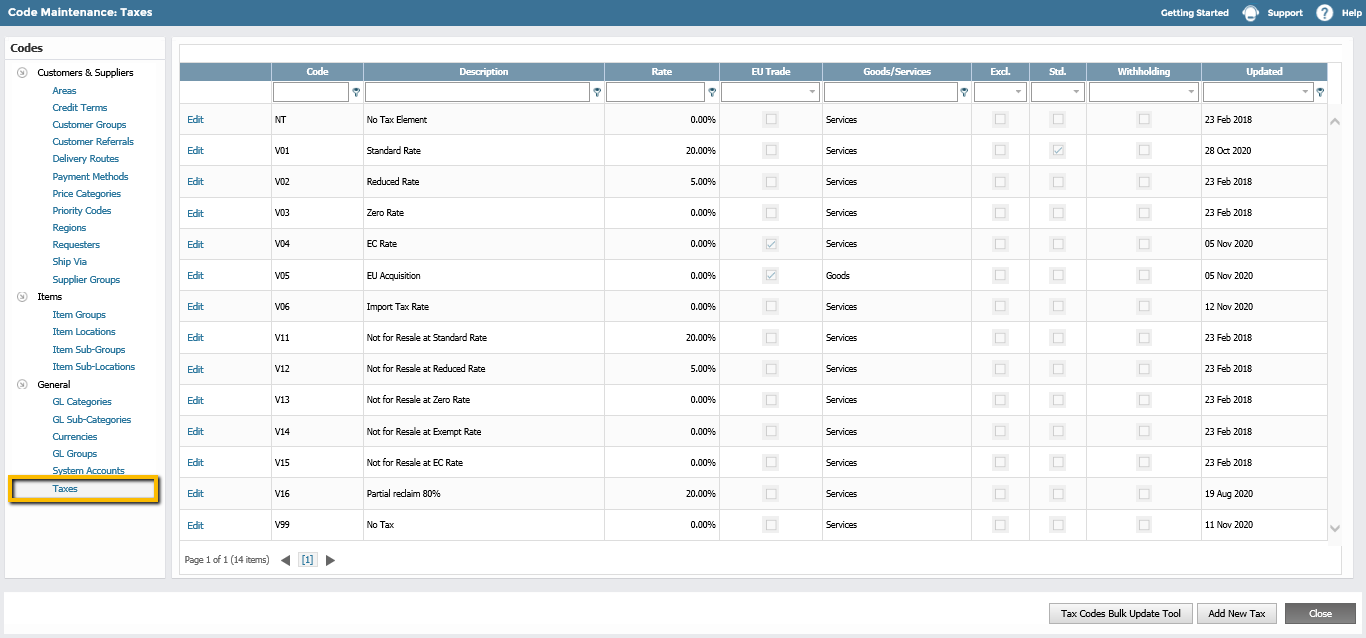1. Adding and Editing VAT Codes
To review the current tax codes in the system, go to Setup>Codes Maintenance>Taxes

The system comes with a set of default VAT codes, but it is your responsibility to check that these are complete and correct for your business and to maintain the codes in the future.
To add a new VAT Code, click on Add New Tax, enter the following details:- Tax Code - tax codes should be unique, alpha numeric and up to 10 characters long. Codes can not be changed once set up.
- Description - tax codes and description can be viewed when entering transactions and on reports, using a meaningful description can help users code transactions correctly. It is not possible to inactivate a tax code, but you can change the description to show that a tax code should no longer be used.
- Rate - this is used to calculate the VAT amount on transactions using this VAT code. Please note you should not change the tax rate on a code once this has been used for transactions - amending tax codes will affect historical reporting, but not transactions. If you need to change the tax rate, set up a new code.
We strongly recommend against making any changes to tax codes once they have been used - making changes to tax codes will not affect any posted transactions, but will affect historical tax reports which can cause confusion. To keep a clean audit trail, we recommend adding new tax codes to reflect any rate changes, or changes to any code settings.
If a tax code has never been used, it can be deleted by clicking on the Delete button. However, it is not possible to delete a VAT code once it has been used, instead, edit the description to indicate that the code should no longer be used.
2. Tax Return Settings
The following settings can be used to correctly configure your VAT codes to meet the needs of your business:
- Standard Tax Rate - one tax rate must be set as the standard. The standard rate is used to calculate reverse charges and to calculate the VAT on transactions when Cash Based Accounting is selected.
- Exclude - any transactions with a tax code that is set to exclude will not be included in any boxes on the VAT return.
-
EU Trade and Reverse Charge
- sales figures will be included in the Sales of goods/services totals on the VAT return and on the Summary of EU Sales report
- reverse charges will be applied to Purchase Transactions at the standard rate for the company
- Reverse Charge / PVA - reverse charges / Postponed VAT Accounting will be applied to Purchase Transactions at the standard rate for the company.
- Partial Reclaimable & Partial Reclaim Rate - selecting this check box and entering a rate will post only the reclaimable portion of the tax to the purchase tax GL Account, the remainder will be added to the net and posted to the expense GL Code.
- Goods and Services - this is used to calculate totals of sales and purchases for Goods and Services
-
Withholding & Withholding GL Account
- For Purchase Transactions this means that the tax amount will be calculated and posted to the nominated Withholding Tax GL code, but this invoice will not appear in the VAT return screen. The Withholding tax amount will not be posted against the VAT on Purchases GL Code but against the GL account that was used when setting up the Withholding Tax code.
- For Sales Transactions – the withholding tax amount will be calculated from the net amount and credited to the nominated Withholding Tax GL code, and will not appear in the VAT return screen.
3. Updating Customer, Supplier and Item Default VAT codes
The system stores default tax codes against customers, suppliers and items, these defaults are then used to prepopulate tax codes when creating transactions. If you add new VAT code(s) you may want to replace the exiting default VAT codes with a new one.
Bulk Updates
To replace an existing default tax code for all customers, suppliers and items with a new one, go to Setup>Codes Maintenance>Taxes>Tax Codes Bulk Update Tool, select the old code to be replaced from the Existing Tax Code drop down and the new code from the New Tax Code Update drop down and click on Process to save the changes.

Please note that the Bulk Update Tool will only change the customer, supplier and item tax code defaults. No changes will be made to posted or processed transactions. If you need to make any changes to transactions, you will need to do this manually in the system, and normal editing restrictions will apply.
Updating Individual Default Tax Codes
You can edit the customer, supplier or item detail default tax codes individually, from:
- the Finance Settings tab of the customer (Sales>Customers) or supplier (Purchases>Suppliers) record
- the Defaults tab of the item (Items>Services/Non-Stock Items or Product Items)
Integrations via the API
If you integrate with other systems via the API, you should make sure that any changes to tax codes are also applied here. In some cases, the API will use customer, supplier or item defaults, but tax codes may be hard coded and so will need to be updated manually. There is no way to bulk update tax rates on incorrectly posted transactions, so you should always check how tax code settings have been applied to integrations with your developers when you add any new tax codes.